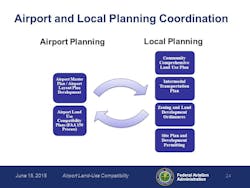Both commercial service and general aviation airports play a vital role in our nation’s air transportation system – providing freedom of mobility, attracting investment and generating local employment.
In addition to connecting small communities to the nation’s transportation network, general aviation airports support vital firefighting, air ambulance, humanitarian and other public service missions benefiting the public.
Today, general aviation airports are under increased pressure from political and community stakeholders to advance environmental sustainability and decrease the impacts of airport operations on the communities they serve – all while meeting the federal requirement to maintain financial self-sustainability.
Strategies To Increase Non-aeronautical Revenue
Airports seeking to increase revenue have several options to consider, such as raising rates and charges, collecting fuel flowage fees and developing revenue-producing facilities. Another viable option is to attract private non-aeronautical land development. This involves the leasing of airport property for compatible commercial uses that are physically separate from airport operating areas and unrelated to aeronautical functions.
Using revenue from non-aeronautical sources to offset or subsidize revenue from aeronautical sources decreases pressure on airports to impose higher lease rates on fixed-based operator facilities and other aviation tenants to cover operating costs. Non-aeronautical leases often take the form of warehouses, light manufacturers, professional and technical centers, and hotel and retail facilities.
An airport’s ability to grow non-aeronautical revenue depends on many factors, including its location, available property, economic conditions and customer demand. Airports with high levels of aviation demand may market property to aviation service providers and develop aeronautical hangar, office and maintenance facilities. Conversely, airports with lower levels of aviation demand may recruit non-aviation tenants for other diverse uses.
It is important to understand that airports establish lease rates for non-aeronautical tenants based on fair market value. The real estate appraisal industry defines market rent as the income a property would most probably command in the open market by the current rents paid for comparable space, reflecting all conditions and restrictions of the lease agreement.
In contrast, airports establish lease rates for aeronautical tenants through an assessment of rental rates at similar or competing airports. This is consistent with the Federal Aviation Administration’s (FAA) Rates and Charges Policy to establish fair and reasonable rates and fees for aeronautical property at airports. Market-based rental rates are derived from similar airports throughout the immediate region, with special attention to similar locational, physical and operational characteristics.
As a result, airport sponsors typically collect higher lease rates, and generate more revenue, from non-aeronautical uses than from aeronautical uses. Aeronautical revenue is often impacted by factors beyond an airport’s control, such as the broader general aviation industry’s performance. Non-aeronautical revenue, on the other hand, generates income from diverse services and facilities.
In simple terms, non-aeronautical revenue offers airports the opportunity to diversify their income streams and reduce dependency on fluctuating aeronautical revenues. While aeronautical revenue is essential, airports need to explore additional non-aeronautical income streams to remain economically healthy, diverse and self-sustaining. This is a well-rounded revenue strategy for airports.
FAA Regulation of Airport Land Use
Notably, FAA grant assurances prohibit airports from charging less than fair market value for non-aviation uses on airport property, which must be factored into any competitive analysis. Also, airports located in areas where developable land is scarce may be able to release airport property from aviation use. This would allow them to lease the land to commercial developers either on a permanent or temporary basis, depending on forecasted aeronautical growth.
Obtaining FAA approval to release airport property for non-aviation use involves a complex process. The FAA recently approved changes to its policy regarding land use changes on federally acquired or conveyed airport land, effective January 8, 2024. These changes were needed because of legislation contained in the FAA Reauthorization Act of 2018. The policy is intended to simplify the procedures required to make a land use change and to protect airport land by limiting the use of releases to the actual sale or disposal of airport property.
In simple terms, federally conveyed or federally acquired land must be used for airport purposes until the FAA approves or consents to a change in land use. In addition, Congress requires the FAA to submit an annual report listing airports not in compliance with airport land use restrictions and identifying necessary corrective action.
The FAA's decision to approve or consent to a non-aeronautical or mixed land use or to release federal obligations generally depends on addressing the following questions: 1) What are the obligating federal documents regarding the property? 2) Does the airport have land that is not needed for aviation use? 3) Will future land uses be compatible with aviation activities?
Overall, aviation tenants and aircraft owners should not be displaced by non-aviation commercial uses that could be conducted off airport property. The FAA must consider both the existing and future aviation demand. In addition, the FAA's authority over a proposed land use change may be limited when: 1) it does not impact the safe and efficient operation of aircraft or the safety of people and property on the ground related to aircraft operations or 2) it does not adversely affect the value of prior federal investments to a significant extent.
The responsibilities of airport sponsors
When considering opportunities to grow revenue, airport managers must be mindful of any FAA or state grant assurances that limit what they may do with and on airport property, and how fees may be assessed. Per the Transportation Safey Board’s Cooperative Research Program, key federal grant assurances include:
· FAA Grant Assurance 5, Preserving Rights and Powers, requires FAA permission before a sponsor sells or leases property shown on the “Exhibit A” property map, which is typically part of an airport layout plan.
· FAA Grant Assurance 22, Economic Nondiscrimination, requires sponsors to treat parties doing business on the airport fairly, and not charge one party more or less for the same level of service.
· FAA Grant Assurance 23, Exclusive Rights, forbids sponsors from setting rates and charges so high that they prohibit new entry of a service provider in order to protect an existing one.
· FAA Grant Assurance 24, Fee and Rental Structure, requires sponsors to set rates and charges to make the airport as self-sustaining as possible.
· FAA Grant Assurance 25, Airport Revenues, prohibit use of airport revenues for non-aviation purposes by the sponsor.
· FAA Grant Assurance 31, Disposal of Land, requires that the sponsor reimburse the FAA when selling property that was originally bought with FAA grants.
State grant assurances are often the same or similar to those from the FAA, with information available at each state’s aeronautics office. While specifics vary, airports that rely on public money for capital improvements are limited in terms of what they can recover through fees and charges. It remains the responsibility of the airport sponsor to find the appropriate balance between revenue maximization and meeting the needs of both airport users and the surrounding community.
Some tools that may assist with the visioning process are an airport master plan, land use plan and airport business plan. Even if non-aeronautical development is financially attractive and beneficial to the community, the airport sponsor must prioritize serving aviation demand and complying with all federal regulations and grant assurances.




